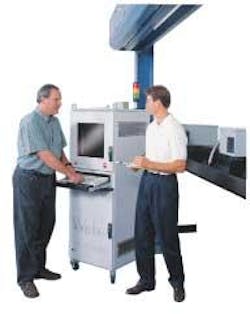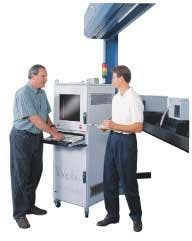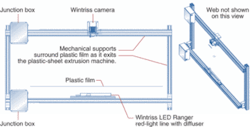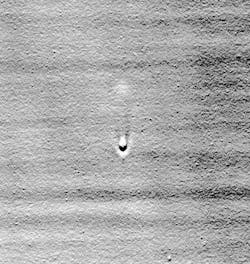Vision system tracks defects in DVD plastic wrap
Mobile smart-camera system tracks defects on a roll of plastic film.
By R. Winn Hardin, Contributing Editor
To protect their investment, movie and video-game rental stores display the original cover of a digital versatile disk (DVD) on the shelf but keep the disk itself in a more-rugged plastic container that both identifies the disk as a rental and helps maintain its quality when rented out. These plastic-disk containers have a cast polypropylene film over the case that holds an insert showing information about the movie. When that disk has passed its commercial prime, the store can use the plastic case for another movie and simply change the paper insert.
American Profol produces the plastic films that are later welded to the cover of the plastic case, creating a plastic envelope for the insert. The film comes out in a 90-in.-wide continuous roll from a plastic extrusion machine.
Profol director of sales and business development Keith Hecthel wanted to provide customers with a baseline of how many defects are present in a typical high-quality roll of plastic wrap. He says that defects tend to come in a 'gel shower,' because dirt or another contaminant is in the raw material and breaks apart. (Gels are polymers that reached melting temperature in the extrusion process, producing visible defects on plastic sheet.)
Hecthel approached web-inspection-system manufacturer Wintriss Engineering for a solution that would track defects but be mobile enough so that the camera could be moved easily from left to right to sample different sections of a roll of plastic film. Wintriss combined its 5150ALC linescan smart camera and LED Ranger red-light line system with a movable mechanical structure and PC host running a Microsoft structured-query-language (SQL) database (see Fig. 1). The camera inspects the film as it leaves the extrusion system and records defect size and location for later retrieval. This information is then used to make adjustments to the extrusion machines to reduce gel defects.
The 5150ALC camera and LED Ranger red-light line are mounted on an aluminum frame that runs above and below the plastic film as it leaves the extrusion machine at American Profol's plant. The frame allows the camera to be moved with three degrees of freedom (translation, pitch, roll). According to Sujoy Guha, Wintriss vision-system designer for the project, the key was to make a supporting structure that could be easily moved between the three extrusion lines and that would be easy enough for a technician to set up and restart the machine (see Fig. 2).
The frame also needed to allow the camera to view different parts of the 90-in.-wide film line. The 5150ALC, which is a 35-mm-format linescan camera, has a 50-mm Rodenstock (now LINOS Photonics) enlargement lens with a custom mount for fine alignment of optics and sensor. The sensor and lens are aligned to minimize optical distortion from the lens, while allowing the camera to use stock lenses rather than special bar lenses sometimes used with linescan cameras. Using a 50-mm-focal-length lens, the system images a 9-in. swath of the film.
Each day, operators at the Profol plant move the camera so that it images a different part of the plastic film (right side, middle, left side). "The system needed to be mobile to keep costs down," said Guha. "An operator pulls the data from the SQL database every couple of days and views the defect-density data. We worked with Profol to create a series of operations within SQL that would chart the defects and show them by type, size, and location." American Profol was not interested in seeing the images, which is why the 5150 ALC works so well here. A smart-camera approach allows the system to send images or just results.
Processing the defects
The camera is located above the film, while the LED Ranger light line with diffuser is placed below, facing upward toward the film and camera above the film. The angle formed between the LED light, film, and camera creates a light and dark artifact in the image for each defect. The 5150ALC camera is a smart camera that includes a Motorola PowerPC chip to control camera operations such as gain and to provide Ethernet communications.
An Altera 10K130 field-programmable gate array (FPGA) with 130,000 gates provides 5.2 BOPS (billion operations per second) of additional power and does all the processing for web inspection in the camera. "We have done web inspection for many years," explains Guha. "In that time, we've determined that there are three main types of web defects: spot, machine direction, and cross direction. That means the defect is either in one spot or runs long either in the direction of emerging plastic from the extrusion machine [machine direction] or across the film [cross direction]."
According to Guha, as each pixel is read from the linescan camera, it is sent down five channels in the FPGA, one for each filter used in image processing (see Fig. 3). The first three channels apply to the three types of standard defects. The fourth channel is a pixel filter that identifies defects that fall at an angle on the film other than machine direction or cross direction. And the fifth channel goes to a large filter to provide continuous background level. The results of the first four filters are compared to the result from the background filter, and a determination is made based on user-defined thresholds.
While the shape of each filter is predetermined, the size of the kernel is determined while the system is trained. A spot filter may use a 2 × 2 pixel kernel, while a machine-direction streak filter may use a kernel of 2 × 64 pixels. "We set the filter size to the smallest expected defect," Guha says. "Typically we do that here at Wintriss using samples from the customer." Guha estimates that the Altera FPGA can process 40 million pixels per second.
Local or remote access
Profol clients wanted to be able to view a graphical representation of the defects and their location on the film at the extrusion machine as well as any PC on the plant LAN. For this reason, Wintriss shipped the system with a standard Compaq (Hewlett-Packard) PC desktop with 512-Mbyte RAM, high-capacity hard drive, and two Ethernet cards. A standard Hoffman OTC junction box acts as an Ethernet hub and power supply for the 5150ALC camera in between the camera and the PC. A second junction box provides power to the LED Ranger light line. The PC maintains the Microsoft SQL database.
The two Ethernet cards communicate with the camera and LAN, eliminating bandwidth constrictions that could arise from the remote access requests during inspection operations. Wintriss also placed a copy of Symantec's PC Anywhere on the PC with a modem in case remote technical support is needed when moving and setting up the system from one extrusion line to the next.
According to Guha, training the operators at the plant is important, as is designing a simple mechanical frame for the camera and light that allows the camera to manually translate across the width of the plastic roll. After the operators have a chance to set up the machine a few times and look at the images they are getting, it is relatively simple for them to move the system.
Early on, PC Anywhere allowed users to look at the images to make sure that the light and the camera were set up correctly. Guha says, "You could basically just grab an image from the camera remotely and tell if it's set up correctly. After the first few months, Profol hasn't needed much help in setting up the system."
Company Info
Altera, San Jose, CA, USA, www.altera.com
American Profol, Cedar Rapids, IA, USA, www.profol.com
Hewlett-Packard, Palo Alto, CA, USA, www.compaq.com
Hoffman, Anoka, MN, USA, www.hoffmanonline.com
Microsoft, Redmond, WA, USA, www.microsoft.com
Motorola, Schaumburg, IL, USA, www.motorola.com
LINOS Photonics, Milford, MA USA, www.linos-photonics.com
Symantec, Cupertino, CA, USA, www.symantec.com
Wintriss Engineering, San Diego, CA, USA, www.weco.com



